A while ago, reader Dave Shevlin wrote to me about his latest project of picking somewhere around 30 or so of his favorite Bat-centric tales for an imaginary deluxe volume and challenged me to do the same. The idea would be to choose, not all-time classics like The Dark Knight Returns and Year One, but personal favorite issues that could be put into a big tome of must-have Bat-comics. Obviously, this appealed to me, but I immediately got stuck wondering what classics I could leave out in order to make room for my more peripheral or obscure choices… With that in mind, I ended up preparing a list of works I expect every Batman fan is bound to read (or at least be aware of) regardless of my recommendation, which I can therefore refrain from including in my ideal anthology (even if I think they’re really good).
I will tell you about my final picks next month, but for now I’ll leave you with this preliminary selection of seminal stories that are easy to find (they’ve all been collected multiple times) and should be required reading for any fan. These are comics that profoundly shaped the Caped Crusader and his world – they’re super-influential tales that subsequent creators kept riffing on, referencing, or somehow paying homage to… Reading them means understanding much of the historical evolution and intertextual subtext of the books that followed. Yes, they’re already so well-known and regarded that I wouldn’t include them in my imaginary deluxe volume, but perhaps they’re worth listing for the checklists of new fans:
1.‘The Case of the Chemical Syndicate’ (Detective Comics #27, cover-dated May 1939), by Bill Finger (script), Bob Kane (art & letters)
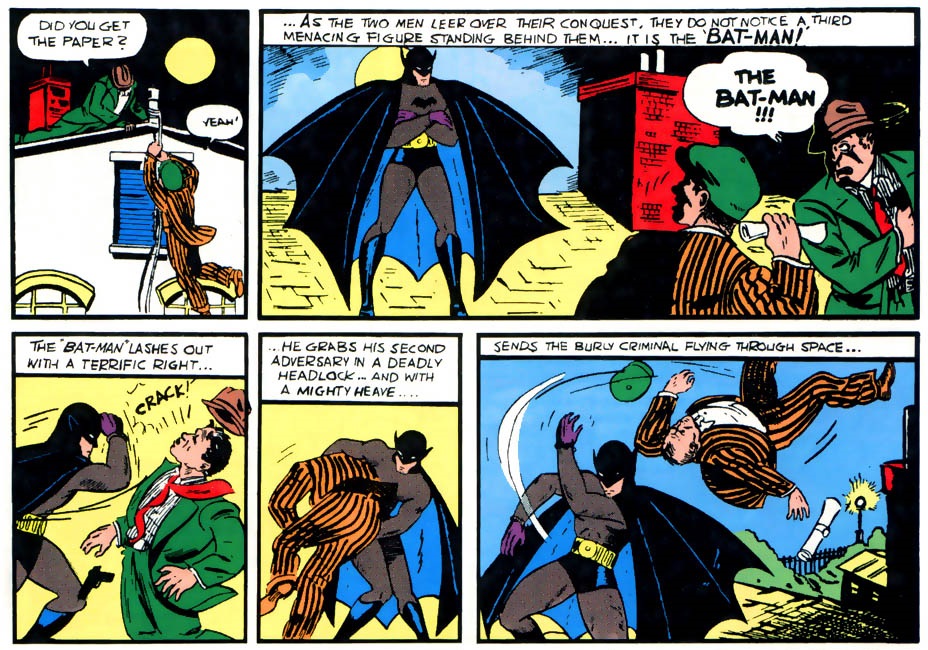
The story that set the stage for everything to come. I’ve wrote a bit about how this tale has been remade throughout the decades here, including the following summary: ‘Originally published in 1939, the six-page ‘The Case of the Chemical Syndicate’ (Detective Comics #27), by Bob Kane and an uncredited Bill Finger, was the first comic to feature Batman (or the Bat-Man, as he was called at the time). The plot is a modest, no-frills whodunit – swiped from a Shadow short story – about the murder of a chemical industrialist called Lambert. Neatly, the Dark Knight shows off what would become his trademarks: he punches crooks (three times), escapes from a deathtrap (a gas chamber for guinea pigs), and deduces the solution to the mystery. There are some rough edges, for sure, but I love the fact that the very final twist is the revelation that the Bat-Man is actually the rich socialite Bruce Wayne! (Sorry for the mega-spoiler.)’
2. ‘The Origin of the Batman!’ (Batman #47, cover-dated June-July 1948), by Bill Finger (script), Bob Kane (pencils), Charles Paris (inks), Ira Schnapp (letters)
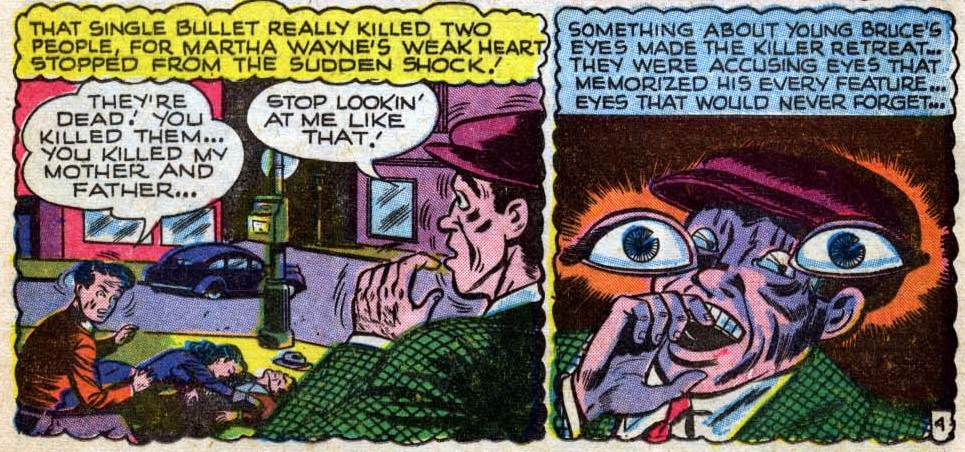
This is one of the most important retellings of Batman’s origin, establishing for the first time the identity of the Waynes’ killer. It also works as an example of the film noir-tinged sensibility of the character’s Golden Age, since it’s a proper crime yarn filled with murder, action (including a dynamic fight at a gambling ship), and an ironic ending. (The final confrontation with Joe Chill was later beautifully redone in The Untold Legend of the Batman #1, which is highly recommended for anyone seeking a crash course on the Dark Knight’s history, even if it isn’t as essential a reading as the comics on this list.)
3.‘The First Batman’ (Detective Comics #235, September 1956), by Bill Finger (script), Sheldon Moldoff [as Bob Kane] (pencils), Stan Kaye (inks)
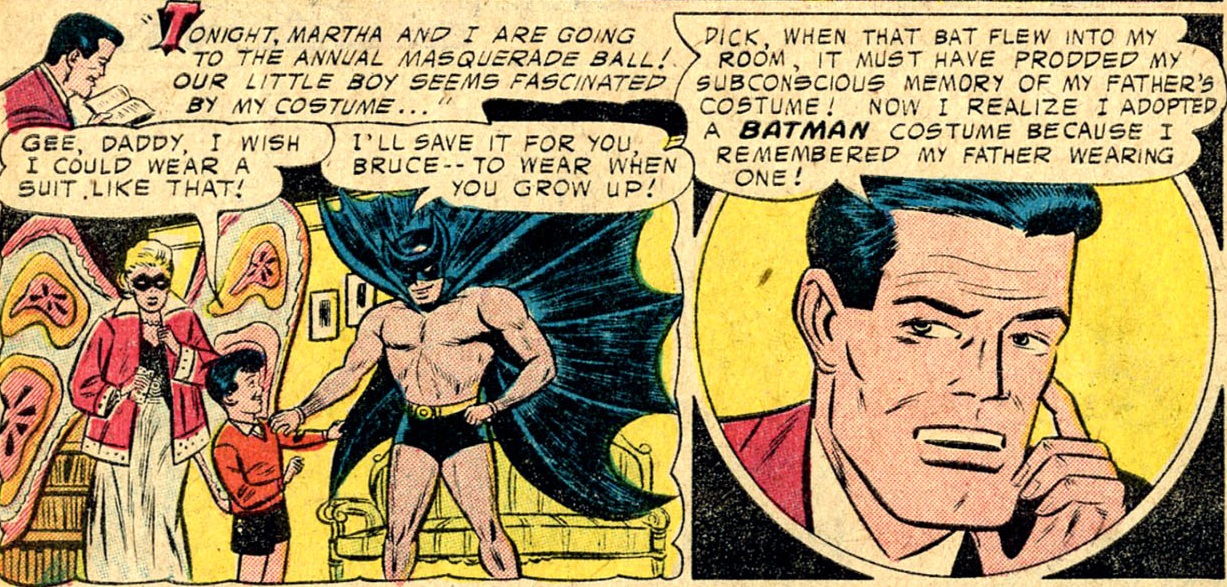
This story not only introduced the idea that Thomas Wayne had once wore a Batman suit of sorts (subconsciously influencing Bruce), but – building directly on ‘The Origin of the Batman!’ – it also added further details about the Waynes’ murder, revising key elements of that fateful night. I usually dislike tales that take an origin as simple and effective as the Batman’s (especially the bit about him being the product of a *random* crime by a small-time crook) and turn them into something needlessly convoluted (there is even an amnesia subplot!), but this one has charm to spare and it did add elements to the mythos that stayed around for years. (In 2010, the Brave and the Bold cartoon show did an awesome episode called ‘Chill of the Night,’ which combined bits from ‘The Origin of the Batman’ and ‘The First Batman’ into a modern retelling that featured a truly hardboiled scene with Lew Moxon’s deathbed confession, a faustian/cosmic contest between the Spectre and the Phantom Stranger, amusing cameos by the rogues’ gallery, and the scariest sounding Dark Knight in living memory.)
4.‘Robin Dies at Dawn’ (Batman #156, cover-dated June 1963), by Bill Finger (script), Sheldon Moldoff [as Bob Kane] (pencils), Charles Paris (inks), Stan Starkman (letters)
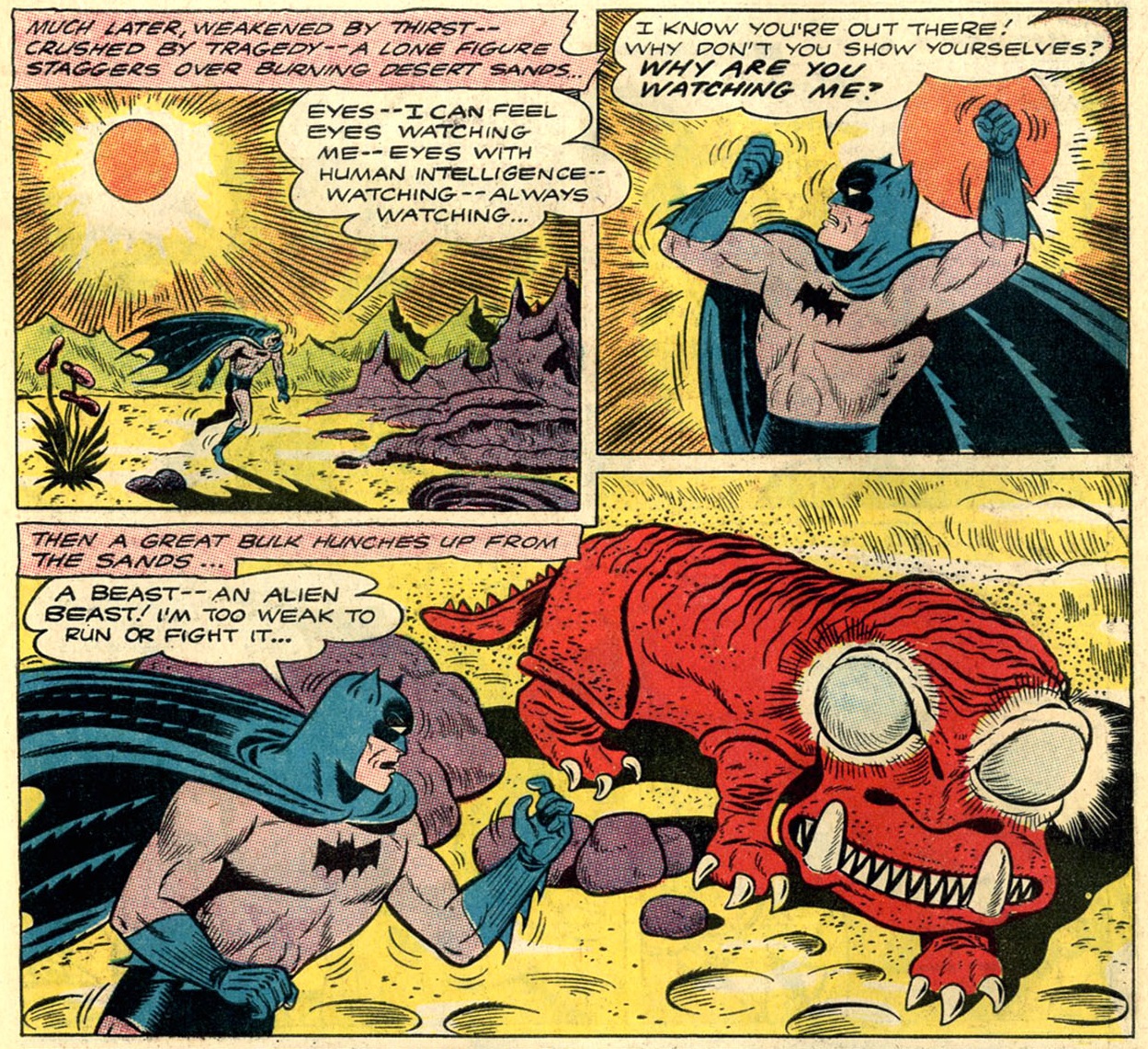
Another gem by Bill Finger and Sheldon Moldoff (ghosting for Bob Kane). A high point of Silver Age sci-fi weirdness (the first part of the story takes place on an alien planet with bizarre creatures and psychedelic colors), nowadays ‘Robin Dies at Dawn’ (like the similarly trippy ‘Batman – the Superman of Planet X!’) is perhaps mostly known for its role as a major inspiration for Grant Morrison’s Batman run. However, this kooky tale – in which the Caped Crusader keeps hallucinating about the Boy Wonder’s death while fighting the Gorilla Gang – already had a cult following before that, not least because of the whole metafictional angle of Batman feeling that he is being watched by ‘eyes with human intelligence.’ (Appropriately for a comic with such an unsettling vibe, it shares some of its premise with the pilot episode of The Twilight Zone.)
5.‘Ra’s al Ghul saga’ (Detective Comics #411, Batman #232, Batman #242-244, cover-dated May 1971-September 1972), by Denny O’Neil (script), Bob Brown, Neal Adams, Irv Novick (pencils), Dick Giordano (inks), Ben Oda, John Costanza, Ray Holloway, Jean Izzo (letters)
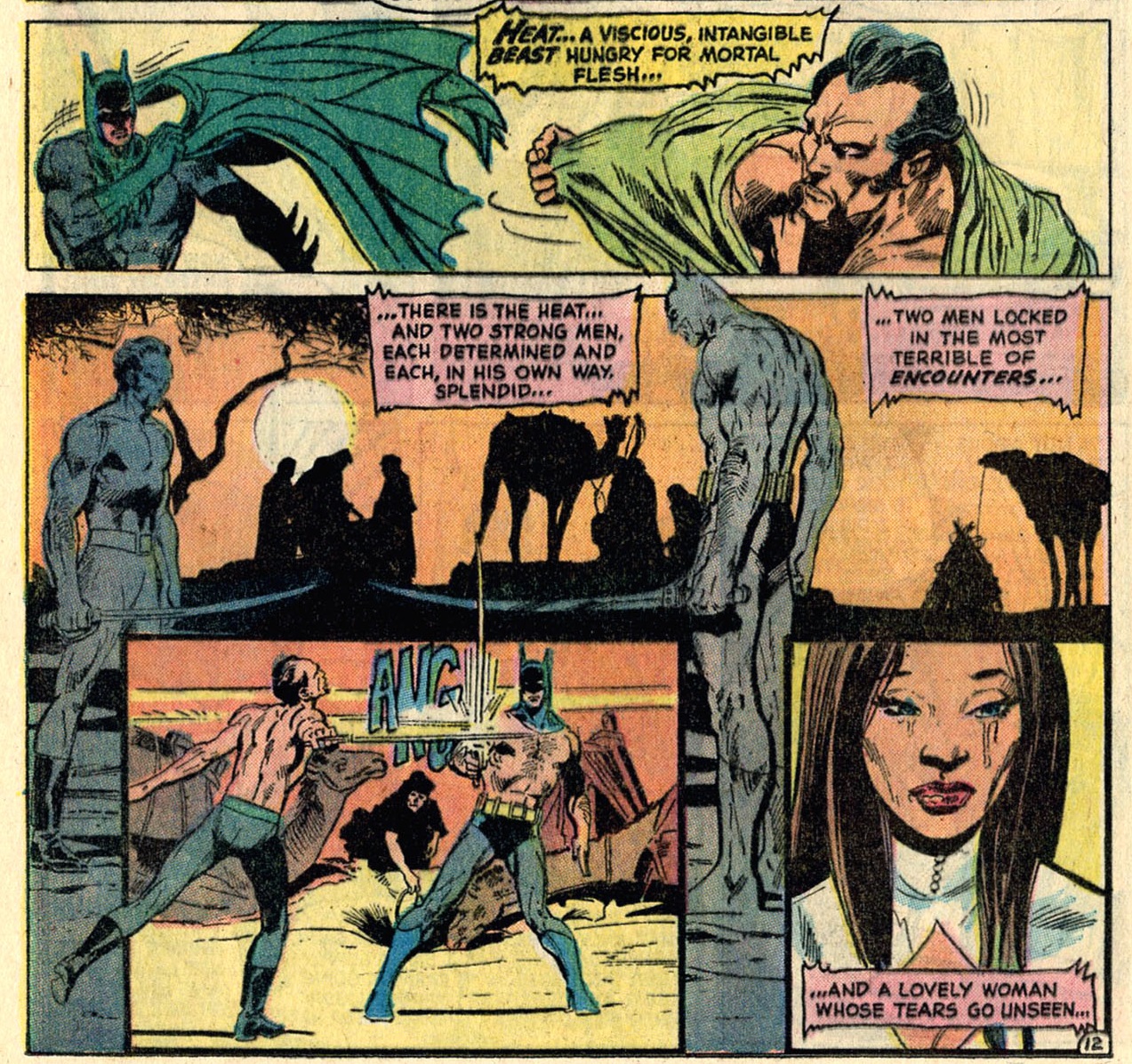
The quintessential Bronze Age Batman story – a hell-for-leather epic that throws the Dark Knight (meanwhile redesigned by Neal Adams) into the globetrotting thrills of a vintage James Bond flick while introducing two of his greatest supporting characters: Talia and Ra’s Ghul. There are a handful of comics that could be seen as part of the saga, but Detective Comics #411, Batman #232, and the trilogy Batman #242-244 are the ones later creators keep going back to. I wrote about them here, including the following lines about the earlier issues: ‘We are definitely in grand adventure territory here. Accepting the genre’s inherent orientalism, [Denny] O’Neil combined different cultures with gusto in order to provide an out-of-this-world sense of exotic excitement: the tale takes place in an unidentified Far East country (‘a tiny Asian nation tucked into the mountains between two hostile super-powers’); we are told Ra’s al Ghul is Arabic for ‘The Demon’s Head;’ a plot point involves arms deals in South America; and in a great sequence Batman literally has to bullfight for his life. O’Neil followed this with Batman #232, where the Caped Crusader wrestles a leopard in Calcutta and climbs one of the Himalayan Mountains, under fire.’
6.’The Joker’s Five-Way Revenge!’ (Batman #251, cover-dated September 1973), by Denny O’Neil (script), Neal Adams (art)

Besides the Ra’s al Ghul saga, the duo of Denny O’Neil and Neal Adams did several other stories together that can be considered classics (‘The Secret of the Waiting Graves,’ ‘Ghost of the Killer Skies,’ ‘A Vow from the Grave,’ ‘Half an Evil,’ ‘Night of the Reaper’), but none as influential as ‘The Joker’s Five-Way Revenge!’ This tale revamped the Clown Prince of Crime, taking him back to his murderous roots (after having been softened for almost two decades because of the Comics Code) while updating his look and style – it effectively kickstarted a version of the Joker that would linger for many years to come. The issue features two of Adams’ most famous splash pages: the opening one, with the Joker laughing behind the wheel of a car, and the one near the end, with the Caped Crusader running purposefully on the sand. Likewise, the deathtrap at the aquarium and Batman’s subsequent fight against a shark – probably a rebuttal of the infamous Shark Repellent Spray joke from the 1966 Batman movie – is fondly remembered and occasionally revisited (1994’s Mad Love has quite a fun variation of it).
7.‘There is No Hope in Crime Alley!’ (Detective Comics #457, cover-dated March 1976), by Denny O’Neil (script), Dick Giordano (art), Terry Austin (backgrounds), Ben Oda (letters)
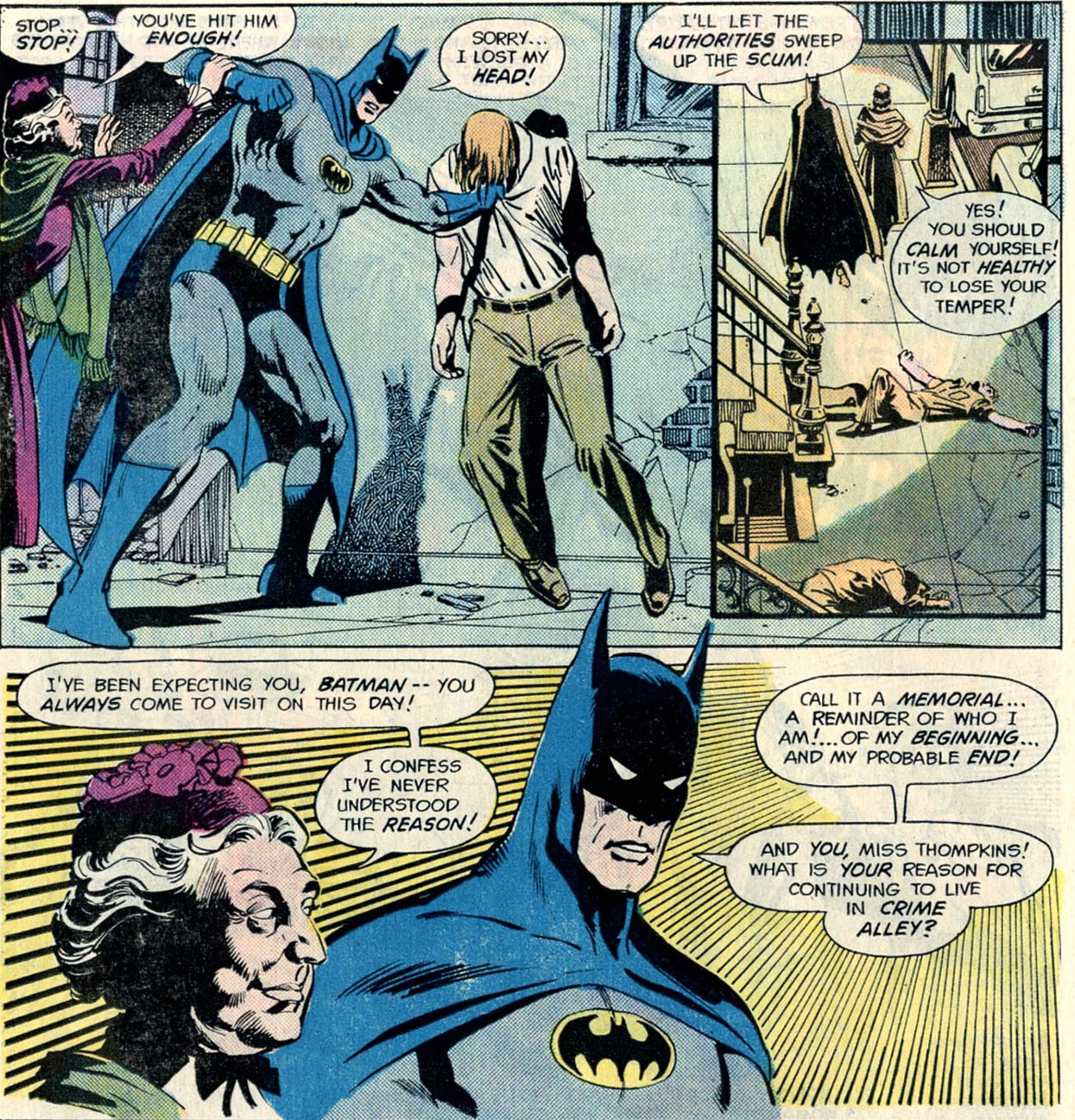
The tale that established the place where the Waynes were shot (Park Row, now known as Crime Alley) and introduced Bruce’s ersatz-mother figure, Leslie Thompkins. Besides representing all that’s worth saving in Gotham City (‘Maybe the only hope our tormented civilization has left!’), Thompkins is a nice counterpoint to the Dark Knight, trying to achieve the same goal as him with pacifist methods. In that sense, this issue paved the way for all those later explorations of Batman’s morals and methods, challenging him in his own series (O’Neil had already tried a similar thing in ‘The Batman’s Burden,’ but that story didn’t leave much of a mark). All in all, ‘There is No Hope in Crime Alley!’ may be a bit schmaltzy and it’s set during an odd time when Alfred wasn’t aware of the Waynes’ murder date (because his pre-Crisis version only met Bruce as an adult), but the ending feels genuinely tender and many of its classic lines have been echoing through Batman comics ever since.
8.‘Strange Apparitions’ (Detective Comics #469-476, cover-dated May 1977-April 1978), by Steve Englehart (script), Walt Simonson, Marshall Rogers (pencils), Al Milgrom, Terry Austin (inks), Jerry Serpe, Glynis Wein (colors), Ben Oda, John Worman, Milt Snappin (letters)
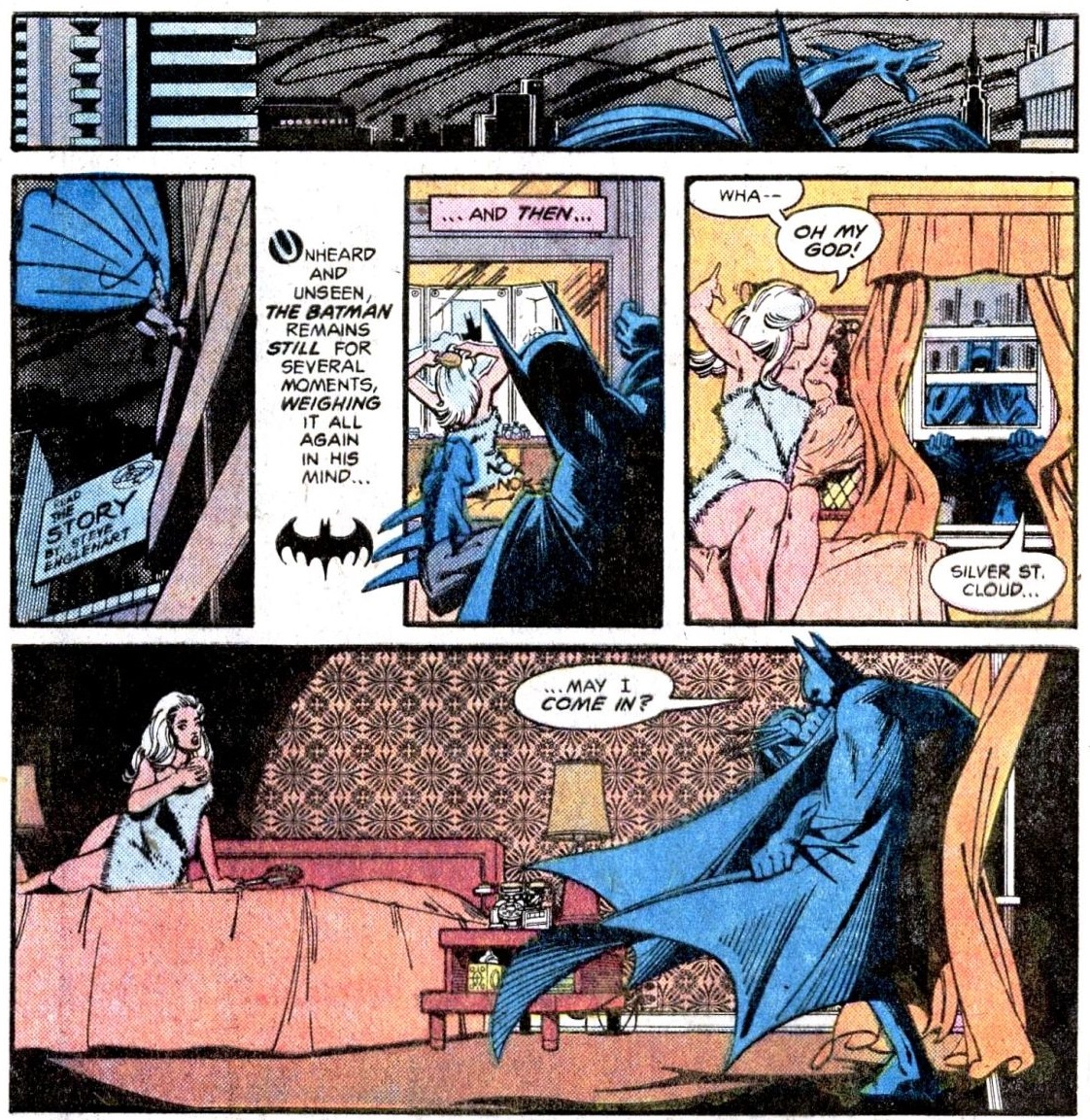
Steve Englehart’s fan-favorite run in Detective Comics (especially the issues pencilled by the incredible Marshall Rogers, #471-476) excelled at drawing from Batman’s past while delivering something that felt fresh and modern. In that sense, it wasn’t just these comics’ characterization, designs, and story ideas that proved highly influential, but their whole attitude (especially when it came to the 1990s’ Batman: The Animated Series). The run works as a cohesive whole due to the overarching subplots about mad scientist Hugo Strange, political boss Rupert Thorne, and Bruce’s love interest Silver St. Cloud, even if it contains different stories within it, including the two-parter ‘The Laughing Fish!/Sign of the Joker!’ (one of the most emblematic stories ever told about the Clown Prince of Crime). I’ve written about this run here and you can find more praise for it here.
9.‘Death Strikes at Midnight and Three’ (DC Special Series #15, cover-dated Summer 1978), by Denny O’Neil (script), Marshall Rogers (art)
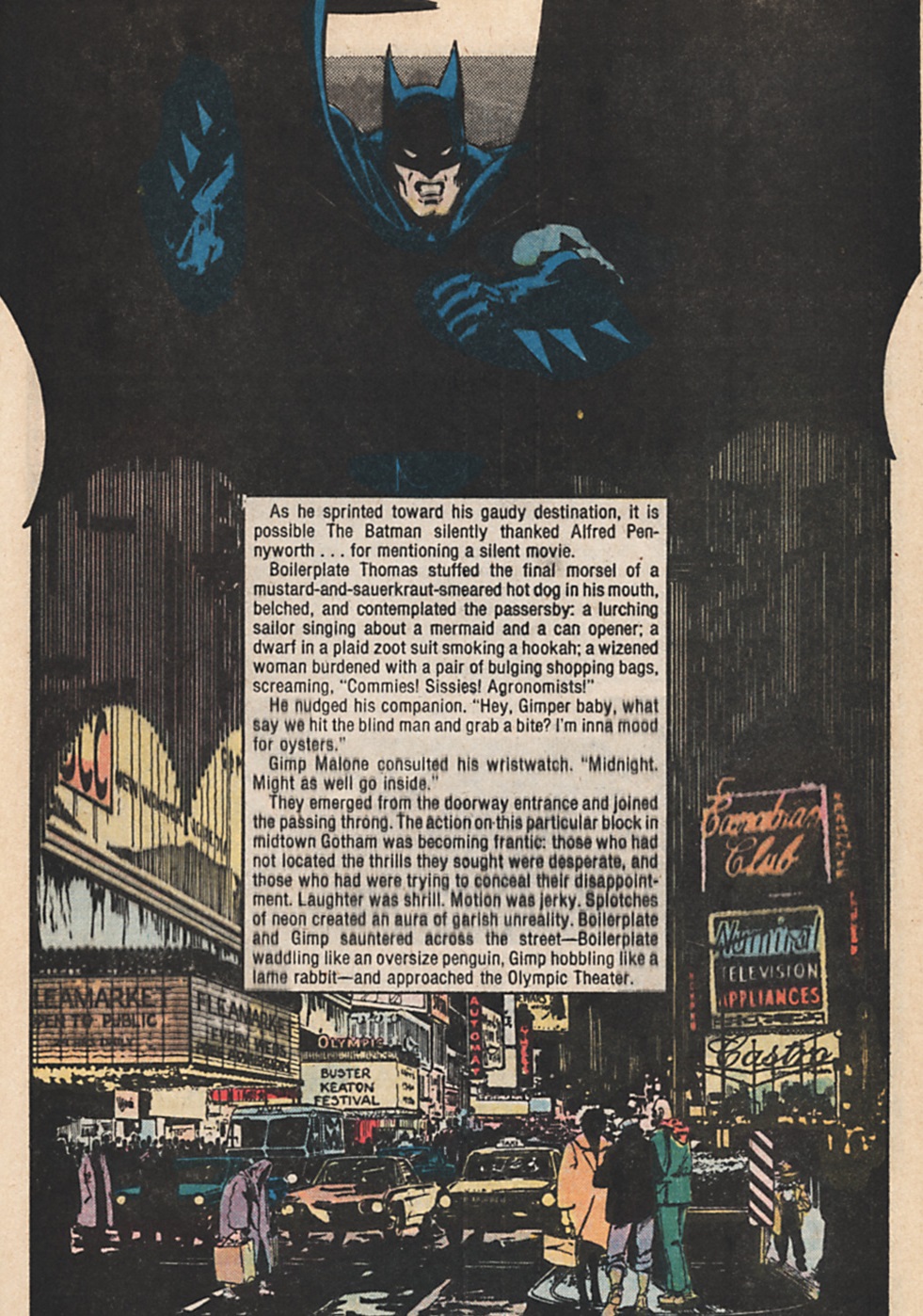
Yes, it’s another script by Denny O’Neil and another art job by Marshall Rogers, but ‘Death Strikes at Midnight and Three’ is a completely different beast from what came before. This taut, gritty short story pushes Batman’s crime fiction angle as far it can go, to the point of practically becoming an illustrated prose piece reminiscent of old pulps (and a damn fine one at that). Everyone who subsequently tried to experiment with the Dark Knight’s ties to noirish literature did so under the shadow of this comic.
10.‘The Dark Knight Returns’ (The Dark Knight, cover-dated 1986), by Frank Miller (script and pencils), Klaus Janson (inks), Lynn Varley (colors), John Costanza (letters)
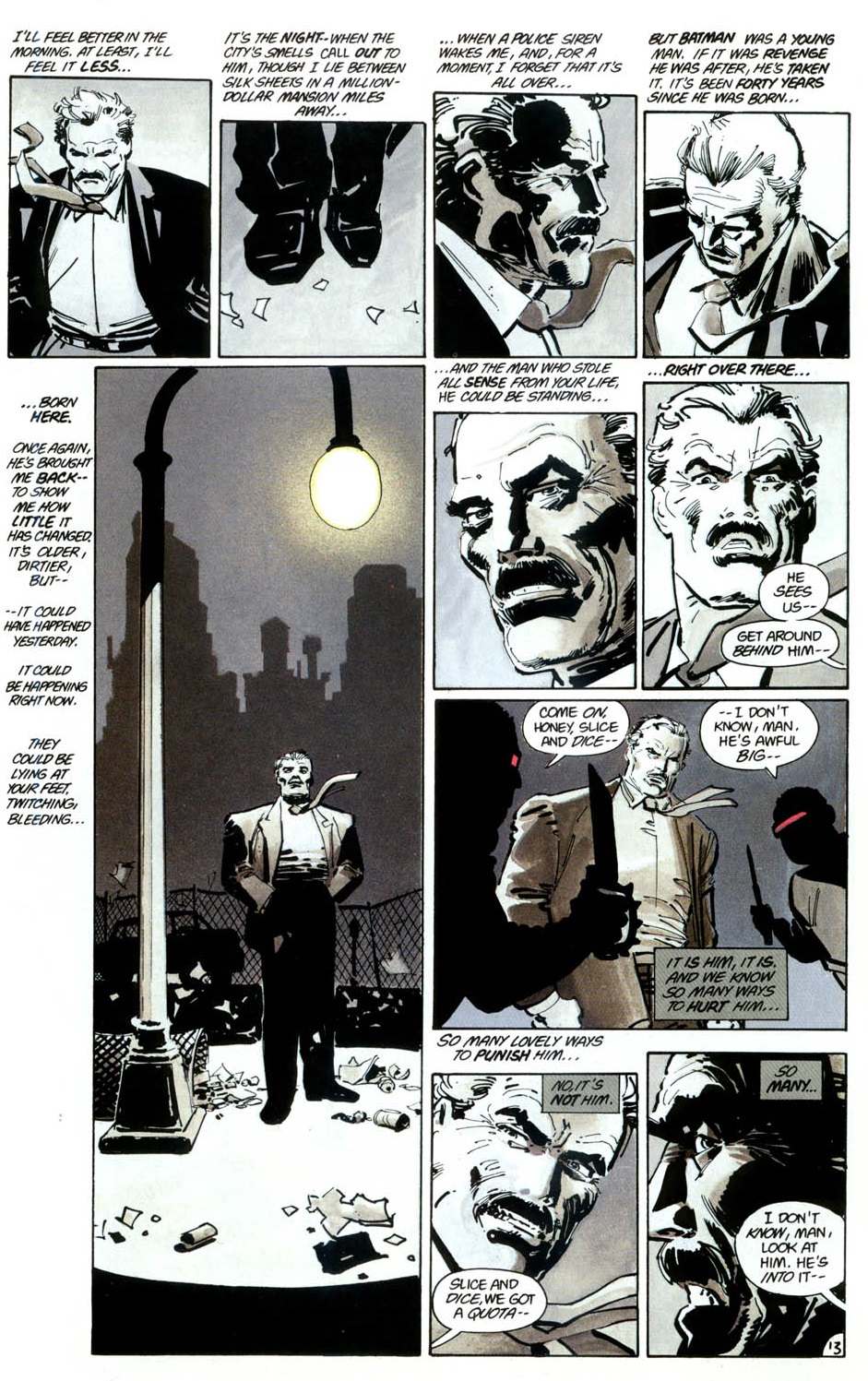
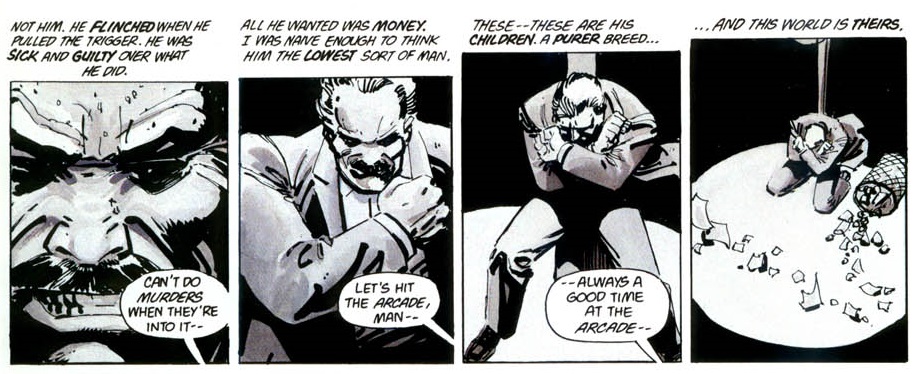
The one book that’s required reading not just for Batman fans, but for any fan of the superhero genre (or for anyone interested in the history of mainstream comics). Frank Miller blew everyone away with his formally innovative and politically charged tale about an older Batman coming out of retirement in a near-future that looked like a grim extension of Reagan-era Cold War. The powerful impact of The Dark Knight Returns (especially of the climactic face-offs with the Joker and Superman) can still be felt today, in both comics and superhero movies. I wrote about it here and Geoff Klock did a poignant analysis of DKR’s revisionary contribution in his fascinating book How to Read Superhero Comics and Why, including the following passage: ‘Miller has often stated that the only thing contemporary comics have learned from The Dark Knight Returns is the extreme level of violence it presents. His own work is not so much violent as it is more graphic and more realistic about the violence that has always inhabited superhero narratives. With The Dark Knight Returns, the reader is forced to confront what has been going on for years between the panels. Miller’s realism operates as a kind of commentary on a genre that has treated its inherent violence with kid gloves. Take, for example, the fact that Batman has in the course of his history gotten into many fights in which he is outnumbered and his opponents are armed with guns. Using only a Batarang and his fists, Batman manages to defeat them all without breaking a sweat. Miller never treats his hero so gently – his Batman is almost always wounded, sometimes badly, and the Batarang is reconceived as a kind of bat-shaped throwing star that disarms by slicing into the forearm, rather than its former, sillier portrayal as a boomerang that disarms criminals by knocking weapons out of their hands. The strength of Miller’s portrayal leaves readers with the impression that all of Batman’s fights must have been of this kind, but that they have been reading a watered-down version of the way things ‘really happened.’’
Honorable mentions (pre-Crisis): Although not as iconic as these tales, other first appearances are worth noting, such as those of Robin/Dick Grayson (Detective Comics #38, April 1940), the Joker (Batman #1, June 1940), Two-Face (Detective Comics #66, August 1942), the Riddler (Detective Comics #140, October 1948), Bat-Mite (Detective Comics #267, May 1959), Poison Ivy (Batman #181, June 1966), and Batgirl/Barbara Gordon (Detective Comics #359, January 1967). The origin tales ‘The Secret Life of Catwoman’ (Batman #62, December 1950-January 1951) and ‘The Man Behind the Red Hood’ (Detective Comics #168, February 1951) are minor classics as well.
NEXT: More essential comics.
